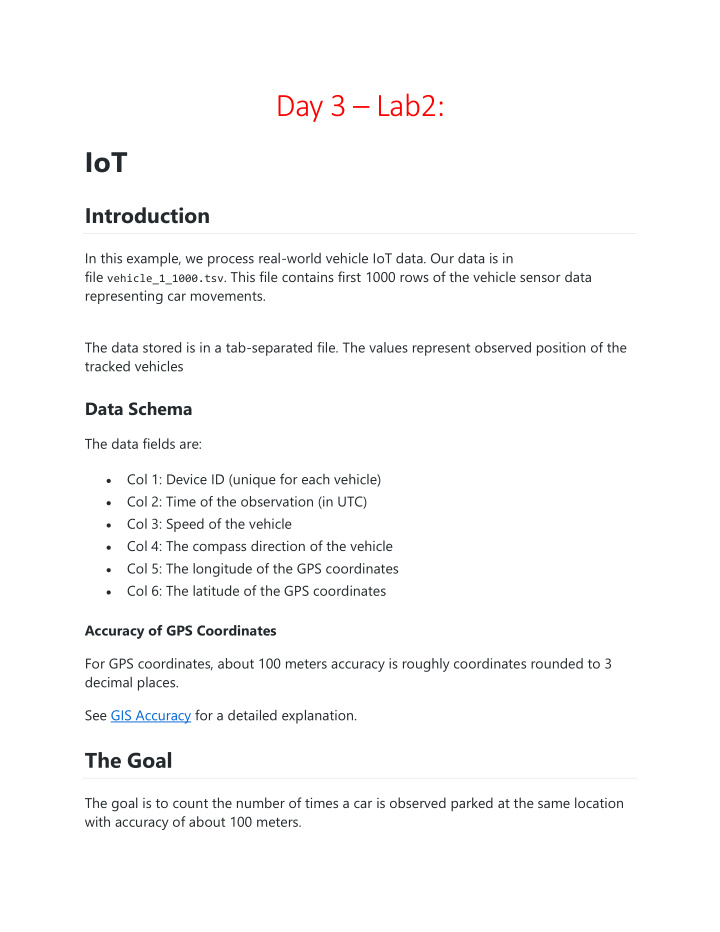



Day 3 – Lab2: IoT Introduction In this example, we process real-world vehicle IoT data. Our data is in file vehicle_1_1000.tsv . This file contains first 1000 rows of the vehicle sensor data representing car movements. The data stored is in a tab-separated file. The values represent observed position of the tracked vehicles Data Schema The data fields are: Col 1: Device ID (unique for each vehicle) • Col 2: Time of the observation (in UTC) • Col 3: Speed of the vehicle • Col 4: The compass direction of the vehicle • Col 5: The longitude of the GPS coordinates • Col 6: The latitude of the GPS coordinates • Accuracy of GPS Coordinates For GPS coordinates, about 100 meters accuracy is roughly coordinates rounded to 3 decimal places. See GIS Accuracy for a detailed explanation. The Goal The goal is to count the number of times a car is observed parked at the same location with accuracy of about 100 meters.
The Solution Let's get started! We will begin with the Spark Streaming program. Spark Streaming Program Our program will read the data from a Kafka stream and print the number of times a vehicle has been observed parked at the same location (within 100 meters). Define Vehicle data case class VehicleStr(id: String, timeUtc: String, speed: String, compassDir: String, longitude: String, latitude: String) Rounding Function for GPS Coordinates def roundAccuracy(coordinate: String, decimalPoints: Int): String = { val Array(intPart, decimalPart) = coordinate.split("\\.") intPart + "." + decimalPart.substring(0, decimalPoints) } Function for Updating State This is for the sate update at the end of each interval. /* * State update function. The state is a collection of keys and values. * Key: (id, long, lat) * Value: number of times parked */ def updateParkedVehicles(batchTime: Time, key: (String, String, String), value: Option[Long], state: State[Long]): Option[((String, String, String), Long)] = { val noOfTimesParked = value.getOrElse(0L) + state.getOption.getOrElse(0L) val output = (key, noOfTimesParked) state.update(noOfTimesParked) Some(output) }
Key Parts of the main Function See the comments in the code for explanations. Configuration // Show only errors in console val rootLogger = Logger.getRootLogger() rootLogger.setLevel(Level.ERROR) // Consume command line parameters val Array(brokers, topics, interval) = args // Create Spark configuration val sparkConf = new SparkConf().setAppName("SparkKafkaIoT") // Create streaming context, with batch duration in ms val ssc = new StreamingContext(sparkConf, Duration(interval.toLong)) ssc.checkpoint("./output") // Managing state val stateSpec = StateSpec.function(updateParkedVehicles _) // Create a set of topics from a string val topicsSet = topics.split(",").toSet // Define Kafka parameters val kafkaParams = Map[String, Object]( "bootstrap.servers" -> brokers, "key.deserializer" -> classOf[StringDeserializer], "value.deserializer" -> classOf[StringDeserializer], "group.id" -> "use_a_separate_group_id_for_each_stream", "auto.offset.reset" -> "latest", "enable.auto.commit" -> (false: java.lang.Boolean)) Creating and Processing the Stream // Create a Kafka stream val stream = KafkaUtils.createDirectStream[String, String]( ssc, PreferConsistent, Subscribe[String, String](topicsSet,kafkaParams)) // Get messages - lines of text from Kafka val lines = stream.map(consumerRecord => consumerRecord.value) // Accuracy for GPS coordinates // https://gis.stackexchange.com/questions/8650/measuring-accuracy-of-latitude- and-longitude val hundredMeters = 3 // We round the observations within 100 meters val vehicleObservations = lines.map(_.split("\t")). map(strings => VehicleStr(strings(0), strings(1), strings(2), strings(3),
roundAccuracy(strings(4), hundredMeters), roundAccuracy(strings(5), hundredMeters))) val parkedVehicles = vehicleObservations.filter(_.speed == "0") val parkingCountsRaw = parkedVehicles.map(v => ((v.id, v.longitude, v.latitude), 1)).countByValue() // parkingCountsRaw are tuples with the structure: // (((id, long, lat), 1), timesParked) // Drop the "1" field // The structure is now a KV tuple ((id, long, lat), timesParked) val parkingCounts = parkingCountsRaw.map(pcr => ((pcr._1._1._1, pcr._1._1._2, pcr._1._1._3), pcr._2)) Updating the State // Applying the state update val parkingCountsStream = parkingCounts.mapWithState(stateSpec) // The state represented as a DStream - we will use it to check the updates val parkingSnaphotsStream = parkingCountsStream.stateSnapshots() // This will print 10 values from the state DStream // Notice how the timesParked for a vehicle at a location accumulate as we process more data parkingSnaphotsStream.print() // A real app may update a database which feeds a dashboard... Starting the Stream Processing // Start stream processing ssc.start() ssc.awaitTermination() Build and Package In the terminal in the Spark program directory, run sbt assembly . This will create the jar file, which we will later deploy to Spark. Run docker-compose Run docker-compose up from the docker directory.
Create Topic Create topic vehicle-observations $ docker-compose exec kafka /opt/kafka/bin/kafka-topics.sh --create --zookeeper zookeeper:2181 --replication-factor 1 --partitions 1 --topic vehicle-observations Producer Run the producer. $ docker-compose exec kafka /opt/kafka/bin/kafka-console-producer.sh --broker-list kafka:9092 --topic vehicle-observations Deploy $ mv target/scala-2.11/spark-kafka-iot.jar ../docker/spark/ Deploy into Spark. We will use 10 seconds as our interval. $ docker-compose exec master spark-submit \ --master spark://master:7077 \ /app/spark-kafka-iot.jar \ kafka:9092 vehicle-observations 10000 Run and Observe Open the file vehicle_1_1000.tsv . Copy some rows from the file. Paste copied rows from the file in the producer. Observe the output in the Spark terminal. Do it a couple of times. Our programs prints the state of the system (by default print will produce 10 lines). You will see the output like this: ------------------------------------------- Time: 1497802830000 ms ------------------------------------------- ((88,-97.409,27.765),8) ((111,-97.831,30.445),2) ((111,-97.832,30.445),2) ((111,-97.835,30.444),4) ((111,-97.834,30.445),2) ((120,-97.831,30.445),4)
((120,-97.831,30.446),2) ((88,-97.403,27.764),2) ((120,-97.830,30.446),58) ((88,-97.402,27.765),80) This is stateful stream processing - notice how the state of the system gets updated with more data consumed. The last field in the tuple is the number of times we observed the vehicle parked at this location. Done Congratulations! You now have a Spark Streaming IoT program.
Recommend
More recommend